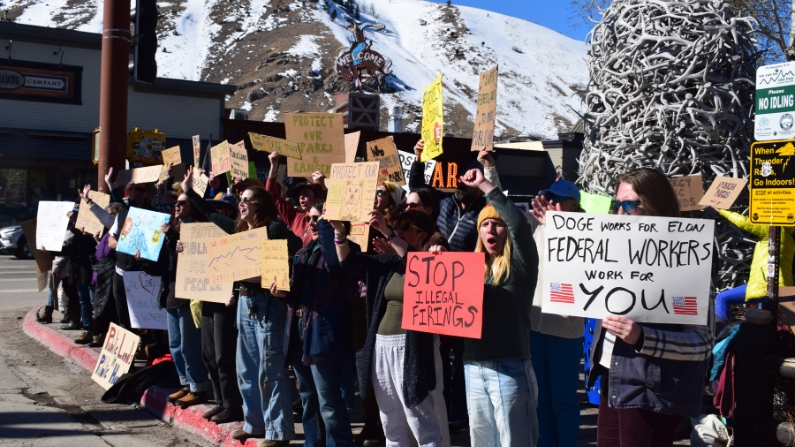In a sea of about 200 protesters in downtown Jackson, Chris Kassar stood on the corner with some fellow wildlife guides and photographers with a sign she said is “no joke.”
It read: “If you fire the rangers, who is going to stop me from petting the bison?”
Visiting Grand Teton and Yellowstone national parks nearly every day, Kassar and her coworkers said they see up close the need for park service employees to keep visitors in check.
“People get really excited and don’t understand how to behave exactly around wild animals,” she said.
Protesters in Jackson were among thousands across the country last weekend who gathered in gateway towns and entrances of national parks to protest layoffs of employees in the National Park Service (NPS) and U.S. Forest Service (USFS).
People have also been gathering at Congress member’s offices and town halls.
Those fired include more than 1,000 NPS employees, according to the Associated Press, and more than 2,000 USFS employees, according to an email from a spokesperson for the U.S. Department of Agriculture, which oversees the Forest Service. In Wyoming, several sources familiar with the Bridger-Teton National Forest told KHOL about 40 employees were fired. That’s about 20% of the full staffing size, according to the Jackson Hole News&Guide.
The Associated Press reported on Feb. 21 that the president had sent a memo that parks can hire seasonal workers, many of whom had previously been subject to a federal hiring freeze. But it remains unclear how many.
Federal land management is an acute issue in Teton County, where 97% of the land is public, overwhelmingly national forest and national park.
Because of that, the region’s firefighters work closely between agencies and across ownership boundaries.
Scott Guenther worked in Grand Teton for 30 years, most recently in emergency services as a Jenny Lake Ranger. He said he’s worried layoffs will mean structures burn – or worse. A USDA agency spokesperson said it’s not laying off “operational firefighters.”
When there’s a fire, Guenther said, everybody lends a hand and interagency support is crucial.
“You come from every job in the park. Admin people go out. Maintenance people go out,” he said.
John, 32, still does wildfire patrol for Caribou-Targhee National Forest and declined to give his last name for fear of retaliation. John drove two hours from Idaho Falls because he believes several of his coworkers were “unlawfully terminated.”
“They were good employees,” he said, “employees that had nothing but good performance appraisals.”
Everyone on his crew who was terminated, he said, played a role in fighting wildfire. Though it’s not the best-paying job, John said protecting public land is a work of passion.
“We are not just desk jockey bureaucrats that a lot of the American people probably think that we are,” he said.
In one of the first successful legal challenges to the Trump administration’s efforts to slash government spending, a U.S. district judge ruled on Feb. 27 that some firings were illegal.
The lawsuit was filed by five labor unions representing federal workers and later joined by several nonprofits. Agencies involved include the NPS and the Bureau of Land Management, but not the USFS.






